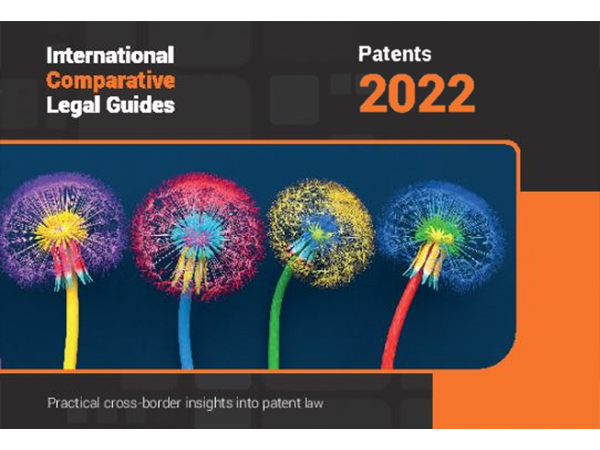
Intellectual Property
Viewpoints
Filter by:
Mintz Secures Victory for AMD at the ITC
April 17, 2018 | Alert | By Michael Renaud, Adam Rizk
Led by Michael Renaud, Jim Wodarski, Mike McNamara, Bill Meunier, Aarti Shah, and Adam Rizk, the Mintz team secured an important victory for its client Advanced Micro Devices (AMD) at the U.S. International Trade Commission (ITC). The case was filed against LG, VIZIO, MediaTek, and Sigma Designs, and it involved complex graphics circuit technology.
Read more
With Software Patents and Means-Plus-Function, “Structure” Takes On a New Meaning
April 17, 2018 | Blog
Software patents are generally directed to a sequence of steps or rules, i.e., an algorithm, performed by a computer programmed to carry out the algorithm. Because algorithms are inherently functional in nature, software patent claims are frequently written using functional, as opposed to structural, terms.
Read more
What is blockchain and how will it affect me?
April 11, 2018 | Blog | By Lisa Adams
The term “blockchain” is everywhere, and it is likely that you will interact with blockchain technology every day in the years to come.
Read more
USPTO Prepares to Celebrate the Issuance of the Ten Millionth U.S. Patent
April 9, 2018 | Blog | By William B. Kezer
The United States Patent and Trademark Office (USPTO) anticipates issuing the 10 millionth utility patent at some point during the summer 2018.
Read more
District Court Grants Protection under DTSA Whistleblower Immunity for First Time
April 6, 2018 | Blog | By Michael Renaud, Nick Armington
The Eastern District of Pennsylvania recently granted immunity under the whistleblower provision of the Defend Trade Secret Act in what appears to be the first decision of its kind under the new federal trade secret statute.
Read more
WesternGeco v. ION Geophysical Corp. and Lost Profit Damages under § 271(f)
April 5, 2018 | Blog | By Adam Samansky, Alexander Roan
Section 271 of Title 35 of the United States Code is the statute that codifies unlawful acts of patent infringement. The most commonly asserted provisions are § 271(a) (direct infringement), § 271(b) (induced infringement), and § 271(c) (contributory infringement).
Read more
Patent Damages: How Many Essential Features in a Smart Phone?
March 30, 2018 | Blog | By Michael Renaud, Andrew DeVoogd, Daniel Weinger
On March 20, 2018, the public version of Eastern District of Texas Magistrate Judge Roy Payne’s March 7, 2018 order tossing a $75 million jury verdict obtained by Ericsson against TCL Communication was released.
Read more
Doctrine of “Ancillary Venue” Does Not Trump TC Heartland
March 28, 2018 | Blog | By Andrew DeVoogd, Anthony Faillaci
Further to our ongoing coverage of post-TC Heartland patent litigation, in a recent development from the Northern District of Illinois, the court granted counterclaim defendants’ motion to dismiss for improper venue.
Read more
AI: The Path of the Future or Industry Hype?
March 19, 2018 | Advisory | By Michael Renaud, Adam Rizk
Companies in many industries are integrating artificial intelligence into their products despite a decline in US AI patent filings driven by uncertainty about the patentability of software. Advances in machine learning are spurring the increased interest in AI.
Read more
Berkheimer v. HP Inc.: Whether Claim Elements Are Well-Known, Routine, or Conventional Is a Question of Fact
March 12, 2018 | Blog | By Michael Newman, Kevin Amendt
The Court of Appeals for the Federal Circuit ruled in February that it was wrong for a judge to rule that a patent was ineligible under the Alice standard because there were underlying factual disputes that could not be resolved on summary judgement.
Read more
Automated Tracking Solutions, LLC v. The Coca-Cola Company
March 5, 2018 | Blog
Automated Tracking Solutions, LLC, (“ATS”) appealed findings of invalidity for failing to claim patent-eligible subject matter by the United States District Court for the Northern District of Georgia.
Read more
Establishing Obviousness: A Fundamental Case of Evidence Over Arguments
March 1, 2018 | Blog | By Brad M Scheller
The Federal Circuit affirmed the Patent Trial and Appeal Board’s inter partes review decision declaring various claims of patent owner Thales’ U.S. Patent No. 6,474,159 (“the ‘159 patent”) nonobvious.
Read more
Latest Tool in the Fight against Alice: USPTO Publishes a New Eligibility Quick Reference Sheet
February 26, 2018 | Blog | By Christina Sperry, Kevin Amendt
Struggling to keep case law relating to subject matter eligibility organized? In February 2018, the United States Patent and Trademark Office (USPTO) released an improved Eligibility Quick Reference Sheet, providing patent practitioners with a useful tool for analyzing claims in view of 35 U.S.C. § 101 subject matter eligibility requirements.
Read more
Updates to USPTO eMod Project to Improve E-Filing/Managing Patent Applications
February 22, 2018 | Blog | By Christina Sperry
The U.S. Patent and Trademark Office (USPTO) is implementing eCommerce Modernization (eMod), as discussed at a USPTO Patent Quality Chat webinar on February 13, 2018.
Read more
Patent Exhaustion Defense Unavailable to Reseller after Impression Products
February 22, 2018 | Blog | By Christina Sperry, Alexander Roan
In an application of 2017 U.S. Supreme Court precedent in Impressions Products, Inc. v. Lexmark Intern., Inc., the Northern District California in International Fruit Genetics LLC v. Orcharddepot.com, No. 4:17-cv-02905-JSW, recently denied a motion to dismiss a claim of patent infringement by holding that the patent exhaustion doctrine did not apply to a sale of a patented product that was outside the scope of the license granted by the patent owner.
Read more
Delaware District Court Finds No Work-Product or Common Legal Interest Protection for Certain Pre-Suit and Pre-Agreement Documents and Communications Between Patent Owner and Litigation Financing Company
February 21, 2018 | Advisory | By Michael Renaud, Andrew DeVoogd, Matthew Karambelas
Recently, the District of Delaware held that a there was no work-product protection, and no common legal interest protection covering communications and documents shared between a patent owner and a third-party litigation financier, where the exchange occurred prior to any written agreement signed between the two parties and prior to the filing of any litigation.
Read more
Federal Circuit Approves Apportioning Damages through a Thorough and Reliable Analysis of the Royalty Rate
February 15, 2018 | Blog
On January 12, 2018 in Exmark Manufacturing Co. Inc., v. Briggs & Stratton Power Products Group, LLC, the Federal Circuit once again addressed the issue of apportioning damages, an area of the law that continues to evolve. The parties in Exmark are competitors in the commercial lawn mower market.
Read more
The Medicines Company v. Hospira, Inc.
February 14, 2018 | Blog | By Brad M Scheller
The Medicines Company (“MedCo”) appealed findings of no infringement made by the United District Court for the District of Delaware. Hospira cross-appealed the district court’s finding that a distribution agreement did not constitute an invalidating “offer for sale” under 35 U.S.C. § 102(b).
Read more
Patent Term Adjustment: Lessons Learned from the Federal Circuit Decision in Actelion v. Matal
February 14, 2018 | Blog | By Christina Sperry
On February 6, 2018, in Actelion v. Matal, the Federal Circuit affirmed the decision of the district court granting summary judgment in favor of the United States Patent and Trademark Office (PTO).
Read more
Improper Reliance on Informal “Opinion of Counsel” Part of Basis for Exceptional Case Award
February 5, 2018 | Blog | By Andrew DeVoogd, Anthony Faillaci
In Drop Stop LLC v. Jian Qing Zhu et al, 2-16-cv-07916 (CACD January 22, 2018), the Central District of California granted Plaintiff’s motion to award attorney fees due to Defendants’ exceptional litigation tactics under 35 U.S.C. § 285.
Read more
Explore Other Viewpoints:
- Data Centers & Digital Infrastructure
- AI: The Washington Report
- Antitrust
- Appellate
- Arbitration, Mediation & Alternate Dispute Resolution
- Artificial Intelligence
- Awards
- Bankruptcy & Restructuring
- California Land Use
- Cannabis
- Class Action
- Complex Commercial Litigation
- Construction
- Consumer Product Safety
- Corporate Governance (ESG)
- Cross-Border Asset Recovery
- DEI Legal Developments
- Debt Financing
- Direct Investing (M&A)
- Diversity
- EB-5 Financing
- Education & Nonprofits
- Employment
- EnforceMintz
- Environmental (ESG)
- Environmental Enforcement Defense
- Environmental Law
- Environmental, Social, and Corporate Governance (ESG)
- FDA Regulatory
- False Claims Act
- Federal Circuit Appeals
- Financial Institution Litigation
- Government Law
- Growth Equity
- Health Care
- Health Care Compliance, Fraud and Abuse, & Regulatory Counseling
- Health Care Enforcement & Investigations
- Health Care Transactions
- Health Information Privacy & Security
- IP Due Diligence
- IPRs & Other Post Grant Proceedings
- Immigration
- Impacts of a New US Administration
- Insolvency & Creditor Rights Litigation
- Institutional Investor Class Action Recovery
- Insurance & Financial Services
- Insurance Consulting & Risk Management
- Insurance and Reinsurance Problem-Solving & Dispute Resolution
- Intellectual Property
- Investment Funds
- Israel
- Licensing & Technology Transactions
- Life Sciences
- Litigation & Investigations
- M&A Litigation
- ML Strategies
- Medicare, Medicaid and Commercial Coverage & Reimbursement
- Mergers & Acquisitions
- Patent Litigation
- Patent Prosecution & Strategic Counseling
- Pharmacy Benefits and PBM Contracting
- Portfolio Companies
- Privacy & Cybersecurity
- Private Client
- Private Equity
- Pro Bono
- Probate & Fiduciary Litigation
- Products Liability & Complex Tort
- Projects & Infrastructure
- Public Finance
- Real Estate Litigation
- Real Estate Transactions
- Real Estate, Construction & Infrastructure
- Retail & Consumer Products
- Securities & Capital Markets
- Securities Litigation
- Social (ESG)
- Special Purpose Acquisition Company (SPACs)
- Sports & Entertainment
- State Attorneys General
- Strategic IP Monetization & Licensing
- Sustainable Energy & Infrastructure
- Tax
- Technology
- Technology, Communications & Media
- Technology, Communications & Media Litigation
- Trade Secrets
- Trademark & Copyright
- Trademark Litigation
- Unified Patent Court (UPC)
- Value-Based Care
- Venture Capital & Emerging Companies
- White Collar Defense & Government Investigations
- Women's Health and Technology






